| Throughout
Britain, there used to be
a whole host of cinemas,
known as Picture
Palaces. These were
magical and marvelous
places. Many resembled
Eastern Palaces while
others took the Art
Deco style to a dizzy
height. People would
stare at these
magnificent structures
and marvel. Families,
courting couples and
friends would go
regularly to them not
only to see the latest
films from Britain and
Hollywood, but also to
enjoy tea, a light lunch
or even dinner in their
restaurants. The staff
members would be dressed
in the livery of the
circuit and would be
considerate and courteous
and show a willingness to
see that patrons passed a
pleasant time. Today,
most of these magnificent
structures have been
destroyed. Like
dinosaurs, many could
not, or were not allowed
to, find a place in the
changing society.
However, some were saved
from the wrecking ball by
the swift intervention of
those who saw beyond
their original use. Some
survived through their
adaption for other uses
and needs of
the changing world and
the fickle tastes of the
public. At
one time, most areas of
Britain could boast of a
local Picture Palace.
And older residents of
the area will most likely
talk merrily about their courting
days and how they
stole that all-important
first kiss with that special
one either at the
back of the balcony or in
the last row of the
stalls. Gone are those
days!
In my part
of the East End, although
we were lucky and had a
number of cinemas to
choose from, we lacked a
true Picture Palace.
We had nothing to compare
in sumptuous grandeur to
the Granada
Tooting
or the State
Kilburn.
And no cinema had the
majesty of the Regent
Brighton.
Even our Odeons
could perhaps not compare
to the wondrous Odeon
Woolwich. None of our
cinemas were as startling
or as opulent as the Astoria
Finsbury Park or as
elegant as the Odeon
Holloway with its
sweeping staircase. The
closest building that we
had which was in anyway
comparable to these
brilliantly startling
edifices was the Troxy
in Stepney.
You may
think that I am crying
in my beer at being
deprived so - not at all!
What we may have lacked
in not having a brilliant
and shining cinema, which
might have brought cinema
lovers from all over
London to marvel at, we
more than made up for in
other ways. We survived
this slight and
bore our under-privileged
state without complaint
for we had three cinemas
that had no rivals –
well, at least to me and
others with taste and
distinction!
Let me say
from the start, I have
always loved going to the
cinema – or as it
was called when I was a
child, The Pictures.
Those that know me know
this to be fact. And as a
child, I not only loved the
picture, I also loved
the cinema itself and
going to The Pictures was
one of the top three
things that I enjoyed
doing best along with
going to The Hackney,
and when I was old
enough, going to the
theatre in the West
End. I have never
tired from or exhausted
the joy that I get from
snuggling down into my
seat, as the lights go
low and the proscenium
curtains swoosh their
way to the flies.
Suddenly, there before
you is a large blank
screen. You wait
patiently for that
magical light from the
projector high above you
to fill the screen with
spectacular images, which
transport you out of your
seat and into some exotic
land or else plunge you
deep into danger as you
creep along hidden in
those menacing shadows
that jut into those dark
and dangerous streets or
perhaps lift you up to a
magical place where
complete strangers
suddenly burst into song
and leap into a dance
consisting of the most
intricate choreography,
all done without missing
a note or step. This was
breathtaking stuff to a
child and guaranteed to
set the imagination
working overtime.
Still, I
am not here to write
about the joys of the
films that I saw, but
rather the places where
they were seen –
those wondrous places
that supplied the setting
for those magical carpet
rides – the cinemas.
Although this is my aim,
I apologize in advance,
since I know that I will
not always be able to
disassociate the
cinema from the film.
In my memory, the cinema
and certain films are
intimately associated and
I fear that, try as I
might, I will not always
be able to separate the
two.
When I was
a child there were
fourteen cinemas open for
business in my small area
of London. Based on the classification
in common usage by us
kids, there were four
really good
cinemas – the ABC
Empire, Mile End Road, the
ABC Regal, Hackney,
the Odeon Hackney Road
and the Odeon Mile
End). Although they
were not exactly picture
palaces, they came a
close second and had
a certain elegance about
them and were not
unpleasant to go to.
After this, there were
two good ones
– the Forester’s
Cambridge Heath Road and
the Excelsior Bethnal
Green. Perhaps I have
allowed myself to
exaggerate the standing
of the Excelsior a
little. If this is the
case, I had reasons,
which will become
apparent a little later.
Next in line came four passable
cinemas – the Essoldo
Bethnal Green Road,
the Empress Mare
Street, Hackney Pavilion and
the Mayfair Brick
Lane. Although we are
moving down the list
here, these cinemas
cannot be ignored, since
the quality of the
films shown could not be
dismissed, and as you
will learn, would elevate
the Essoldo and
the Empress well
beyond what would have
been expected from their
initial lowly position on
the classification list.
Now we come to those
cinemas labeled as dumps
– a somewhat damning
distinction, I am
afraid to say, but one
worthy of their décor
and care given. These
miserable establishments
were the Museum Cambridge
Heath Road, the Standard
Hackney and the Palaseum
Commercial Road. Each was
grim and gruesome and
totally lacking in charm.
But then, I need to
recall what my friend
said about the lack of
permission to renovate
them although their sad
state was not entirely
due to government
interference. Finally,
and with regret, we come
to the bottom category
– the fleapit
– such an
establishment had long
since moved beyond hope.
Mercifully, only cinema
would receive this
rating, the poor and
dejected Empire,
Roman Road.
I have
recently learned
something interesting
from a friend of mine
that has caused me to
feel some regret at my
dismissal and attitude
towards the fleapits.
Following the war, it was
difficult to get planning
permission for anything
other than new houses and
other buildings of
priority. This was done to
get Britain back
on its feet as
quickly as possible.
Since my area of London
was close to the docks,
it suffered badly during
the war. The whole area
was littered with bomb
sites, which although
great places for the
local kids to play needed
to be filled as soon as
possible so that everyone
could be seen to be
returning to a normal
life. During the war
years, many of the
cinemas of the area had
fallen into disrepair.
Naturally, no planning
permission would be given
to use vital materials so
that renovations could be
done. This caused many of
these wounded
cinemas to maintain their
shabby and almost
derelict look well after
the war ended. Money was
still in short supply in
the early post-war years
and people had to be
careful where they spent
it. Although the
pictures were still
popular, patrons wanted
to spend their money on
something special and
since those poor
dilapidated cinemas
failed to project a
welcoming image, they
were decidedly
unappealing to working
people. Naturally, we
children were much
harsher when discussing
these mangy old places
amongst ourselves and
quickly dismissed many
cinemas with total
disregard of reason and
labeled them as dumps and
fleapits and
turned our noses up when
they were mentioned.
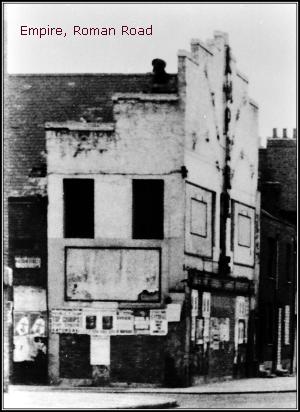 As
I mentioned in my other
story, Going
to the Pictures,
the worst cinema that I
have ever been to –
before or since –
was the Empire in
Roman Road. The Empire
Picturedrome opened
in 1912 and was altered
in 1926 and had a seating
capacity of 650 at that
time. This cinema holds a
place in my memory
since it was the first
cinema that I ever went
to. Unfortunately, this
was not a memorable
experience. The film that
I saw was Snow White
and the Seven Dwarfs,
but I in fact saw little
since I spent most of the
time under my seat out of
fear of the Wicked
Stepmother. As
I mentioned in my other
story, Going
to the Pictures,
the worst cinema that I
have ever been to –
before or since –
was the Empire in
Roman Road. The Empire
Picturedrome opened
in 1912 and was altered
in 1926 and had a seating
capacity of 650 at that
time. This cinema holds a
place in my memory
since it was the first
cinema that I ever went
to. Unfortunately, this
was not a memorable
experience. The film that
I saw was Snow White
and the Seven Dwarfs,
but I in fact saw little
since I spent most of the
time under my seat out of
fear of the Wicked
Stepmother.
The cinema
was whitewashed on
the outside when I knew
it and most of the
letters of the name had
fallen off the wall and
had not been replaced.
There were also the
remnants of electric
lighting in the form of
stars that long since
ceased to work. Also on
the façade were two
empty billboards that
once served to tempt the
patron with their
advertisements. There was
no attractive awning to
protect patrons from a
passing shower while they
waited to enter the
cinema. The box office
was a little window
that opened directly onto
the street and entrance
to the auditorium was
through a small door,
which opened directly
from the street. When I
knew the cinema, it was
in a sad state. It
totally lacked any
semblance of charm and no
one made any effort to
create a welcoming
ambiance. The building
had been reduced to pure
functionalism and looked
unappealing. Over the
years I would pass this
gruesome looking place on
my way to and from the launderette
further along the Roman
Road. The cinema never
seemed to show any films
worth going to see –
only films that had been
seen elsewhere years
early – and which
were without merit. And
in 1959, the cinema
closed and the site was
redeveloped.
After my
initial experience at the
Empire, I never
returned there again. It
is tragic to think that
the Empire was
once an attractive
building with working
illumination and
certainly must have given
much pleasure to the
people of the area.
Sadly, the building fell
into decline and became
the eyesore that I
knew. Sadly no one now
remembers it as it once
was and the building
spent its last days
suffering humiliation at
the hands of the like of us
kids. Upon
reflection, I think that
the shame is on us.
Although
we lacked a real
Picture Palace, we
did have a few upper
level cinemas that
any area would have been
proud to have as their
local cinemas. These were
the Odeons and ABCs
in Hackney and on the
Mile End Road. As the Odeon
Hackney Road and the ABC
Empire, Mile End Road
were closer to where we
lived, these were the
ones we visited the most.
These cinemas were
beautiful places and
amazingly they are both
still in use today: the Odeon
is a Bingo Hall
while the Empire is
now called Genesis
and enjoys a
reincarnation as a
multiplex.
These two
cinemas were great
favourites of mine. We
would often go to the Empire
on Mile End Road on a
Thursday evening when my
parents closed the shop
and took the night off.
Other times, my mother
and I would go on a
Monday night, which was her
night off. My father
did not take a night off.
Instead, he took an hour
off each night and go
across the road to The
White Hart for a
drink. His one hour
off most often turned
into several and we would
be lucky to see him
before closing time.
On
Thursdays, once my
parents closed the shop
after the lunchtime and
finished tidying up, they
would rest for a while
before getting dressed
for their evening out.
Although we would take
care in our appearance,
we would not dress to
the same degree as when
we went to the Hackney.
Going to the Hackney
was a treat, something
special, an occasion,
even though we went quite
often, while going to the
cinema, although
pleasurable and certainly
something to look forward
to, was somewhat ordinaire.
And so we dressed
accordingly since the
local cinema was
definitely not a place to
wear one’s Sunday
best. Despite this, I
was still made to go tidy.
The Empire
was about half a mile
from Mile End Gate along
the Mile End Road.
Normally, I would enjoy
the walk to the cinema,
but when I was on my way
to the pictures, I
would want to rush along
the street since I was
always filled with
excitement at the thought
of at long last seeing
some great film that I
had been waiting to see
for some weeks. In those
days, London had three
evening newspapers –
The Star, The Evening
News and The
Evening Standard. All
over London, one could
hear the newspaper
hawkers calling out Star,
News a’ Standard
and people would pay a
few coppers for any
one of them. Each
evening, my parents would
buy all three and we
would each have one to
read after the evening
meal. This is amusing to
me now since my reading
was not that advanced at
the time. However, I
wasn’t interested in
the headlines or in the
features at that time.
The only thing that
interested me in the
newspaper was the theatre
and cinema listings since
I needed to be fully au
fait with what was
playing or about to be
shown in the West End
cinemas since these films
would soon be shown at
the Empire or some
other cinema in the area
and I wanted to be sure
when exactly.
The walk
along Mile End Road to
the Empire was
very interesting as the
road has a long history
and one that was
intimately associated
with my mother. Just past
The White Hart public
house, there was once a
number of missions
and tabernacles.
These establishments were
once soup kitchens where
the poor and down of
heart went and
received a bowl of soup
and a piece of bread.
While they ate, someone
would talk to them about
the state of their
spiritual life and
following the feast,
everyone joined in and
sang a rousing hymn. My
mother would take her
half-brothers and sisters
to these places when she
was told to take care of
them and don’t
come back before dark,
leaving her mother
and stepfather to enjoy
themselves in their home
free from the
distractions of children.
One of the
missions, founded
by General Booth became
the site of The
Salvation Army.
Today, the mission
is gone, but a statue
erected by American
members of the Army
now stands close by to
make the place where the Army
was founded. My
mother used to tell of
the efforts made by the
members to save
people. At that time, my
part of the East End,
especially Stepney and
Bethnal Green, were
renowned for its wildness
and danger and it
would take a person of stout
heart to dare to
enter a public house and
talk to the patrons. Many
were beaten and I believe
some were killed, but
they persisted and helped
to calm and tame the East
End for a while.
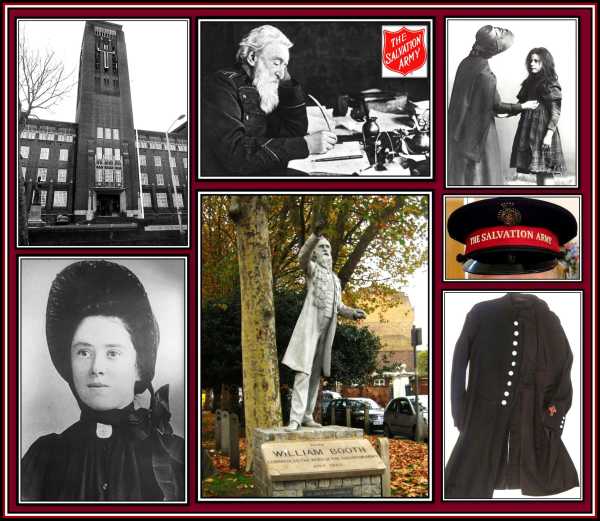
Statue of
General William Booth
(click on
the statue to enlarge)
There were
other places of interest
along the Mile End Road.
There are some old alms
houses still
present. These buildings
are set back from the
road and have decorative
gates, which are
remarkable in that the
tops of each is decorated
with stone replicas of
sailing ships. I am
always amazed when I
visit the area to
discover that these galleons
are still present and
have not been vandalized.
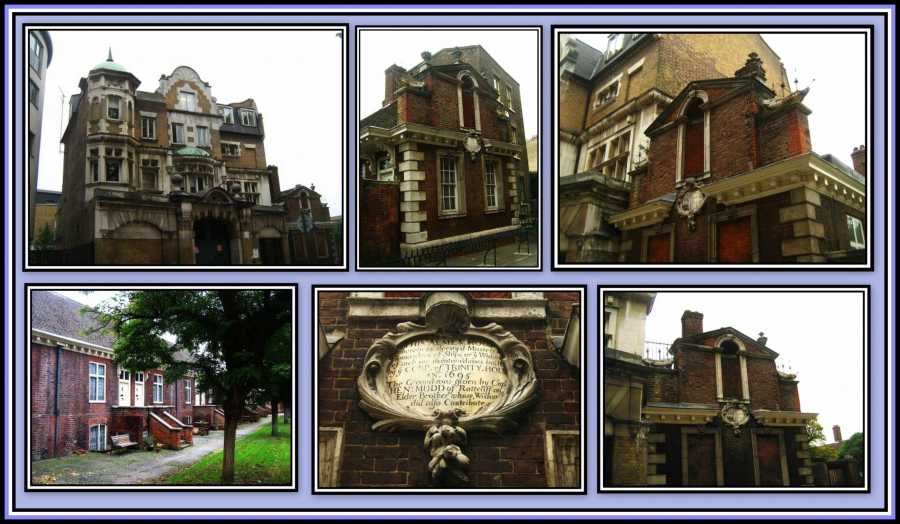
The Alms
Houses, Mile End Road
(click on
the above pictures to
enlarge)
Just
before reaching the
cinema, we passed a large
department store called Wickham’s.
Wickham’s has
a large tower that can be
seen from afar. The store
had large windows and
obviously the company was
proud of the designs that
were in each one. I never
liked the store. I
don’t think that my
mother liked it either. I
remember her complaining
about the price of things
for sale. I remember
disliking the floors.
They were of old slatted
wood and made a din when
you walked on them. Their
lifts were old and
rickety and creaked their
way between floors and
were manned by miserable
operators. Nothing in the
store appealed to me and
the lighting was dreary.
However, the worst
department was the toy
department, which was
found in the basement.
Their toys were
uninteresting and
decidedly overpriced. I
certainly was never of a
mind to spend my hard
earned savings on any
toy from Wickham’s.
Despite my lack of
affection for Wickham’s,
I was saddened to find
that sometime in the
1970s, it closed. The
building is still there
and part of the ground
floor is used by Blockbuster
Video and various
others companies have
leased the remainder, but
none have seemed to stay.
The first floor remains
empty and has been unused
for years. Although the
once beautiful building
seems to be basically
intact, its stonework is
now grimy and stained
from a lack of care and
the windows are dirty
from years of neglect.
The building, once of
some importance in a
one-time vibrant area, is
now left empty to decay
in the now depressed and
forgotten area. It is
like some tragic
figure that has
served its purpose and
now has no place in our
modern world.

Wickham's
Department Store
Between Wickham’s
and the Empire was
a bank of white stone.
This was a small bank,
but I remember that it
was always busy during
working hours. There was
a night safe on
the outside of the
building. As we walked
past the bank on the way
to the cinema, there
would generally be one or
two people depositing
their small dark blue
bank sacks filled with the
day’s takings into
the night safe for
overnight keeping. The
next day, at 10 A.M., the
bank would be open again
for business and
representatives of the
various companies would
come by to retrieve the
sacks and officially make
a deposit of the monies.
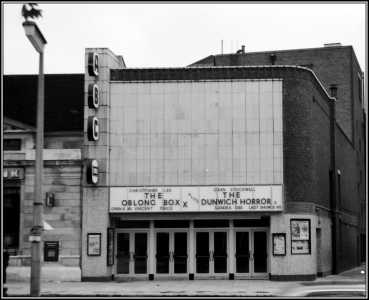
The
Empire, Mile End Road |
|
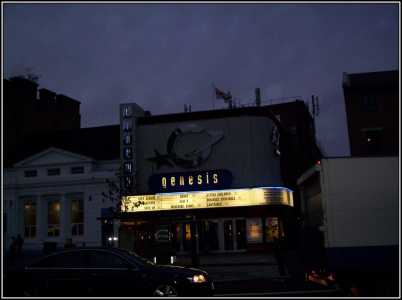
Bank and
Cinema |
Next
to the bank was the Empire.
The site of the Empire
Mile End has been the
site of either a theatre
or a cinema since 1885.
Firstly, there was the Paragon
Theatre of Varieties,
which was designed by
Frank Matcham. The
building was later
converted into a cinema
and operated by the
United Picture Theatres
chain and then by Associated
British Cinemas (ABC).
In April 1938, it was
demolished and a new Art
Deco cinema designed
by William R. Glen was
built by ABC. The
new cinema was named the Empire
and opened on 12th
June, 1939.
The cinema
was nothing out of the
ordinary from the
outside. It was like any
other middle sized ABC
that were found all over
the Britain at the time.
There were several long
picture frames on the
outside of the building
where still
photographs of shots
of the film were placed
in the hope of attracting
patronage. I would always
study these pictures as I
would want to recognize
the scenes when watching
the film. I was often
disappointed to find that
not all the scenes shown
outside to actually be in
the film. I did not
realize that many of
these stills were
posed especially for
advertising purposes.
We entered
through the swing doors
and made our way to the
Box Office, which was
inside in the foyer. I do
not recall any potted
plants or objets
d’art about the
place. The only
decoration that I can
recall was an
advertisement for next
week’s attraction which
appeared over the swing
doors. There was a double
staircase leading to the
circle, which I only sat
in once. This was when we
went to see Showboat. My
mother had been helpful
to a customer and for her
kindness, the lady had
given us her entrance
pass to the Empire,
which treated us to the
film and places in the expensive
seats. To be honest,
I was not overly
impressed with the
seating since I much
preferred to sit closer
to the screen. I needed
to be closer to the
action.
The
auditorium of the Empire
was quite large, but
nowhere near the size of
the ABC Regal, Hackney.
Its Art Deco decoration
was typical of many other
ABCs and consisted
of a series of inverted
steps with scalloped
edges in the ceiling and
horizontal bands on the
side walls. I cannot
remember anything about
the curtains that
separated the screen from
the auditorium. This is
not surprising since I
was much more interested
in their opening than in
their design, as I would
always want them to open
as soon as possible and
allow the film to start.
I enjoyed
our nights out at the Empire
and remember them with
fondness. I used
to look forward to the
trailers. These were
often as important to me
as the feature. In those
days, you were shown only
what was coming next week
and not the endless
number forced on the
cinema-going public of
today. I also enjoyed the
newsreel. It wasn’t
that I was overly
interested in the
stories presented. No, it
was the cockerel used by Pathe
to crow the
introduction of their
presentation that I
liked.
At the
time, believe it or not,
we had two chickens that
were kept on the roof of
the pie ‘n’
mash shop. One was a
mean white bird that I
did not like and who
decidedly did not like
me. The other bird was a
beautiful brown bird, a Rhode
Island Red, that my
mother had named Susie.
I have no idea how Susie
got her name. She was
a delightful chicken.
Friendly and very
accommodating who would
produce one brown egg
each day. It was my job
to collect the eggs early
each morning and, as
carefully as I could, I
would bring them to my
mother in the kitchen.
She would boil Susie’s
egg for exactly four
minutes, no longer and no
shorter, under my
watchful eye. When I was
satisfied that the egg
had been properly
prepared, it would be
lifted gently out of the
pot and placed carefully
in my egg holder, which I
would then be given to
carry to the table. After
tapping the top of the
egg with my spoon and
removing some of the
shell, I would dip my fingers
of toast into it and
proceed to enjoy for
breakfast. Susie produced
one egg each day of her
short life and when I
found her dead one
morning, I was
inconsolable. After this,
my parents could not
bring themselves to get
another chicken. How
could they? No other
chicken could have
possibly replaced Susie.
Anyway, whenever the Pathe
cockerel crowed,
it would be greeted by my
yelling out for all to
hear …. Susie!!! Heaven
only knows what those
about me thought. Still,
I didn’t care what
they thought then and I
certainly don’t care
now!
The
interval would bring
several ice cream
ladies to the
auditorium wearing their
trays and selling
delicacies for patrons to
buy. I suspect that there
was a great turnover in
staff at the Empire since
I never developed any
relationship with them
unlike those of the Hackney
whom I found to be much
prettier and much
friendlier. I would wait
in line, purchased my ice
cream, give them the
money, collect my change,
say thank you and
return to my seat. I
doubt if a smile was ever
exchanged between us.
The Empire
showed the great films of
MGM and Warner
Brothers along with
some British films. And
it was here that I saw
for the first time many
great performances and
many future classic
films. It was here that I
first saw Showboat and
felt the pain endured by
those forced to tote
that barge, lift that
bale and learned the
importance of smiling
when all else fails. It
was here that I
first became acquainted
with Judy Garland. I
recall being very upset
when it looked as if Fred
Astaire would choose Ann
Miller over her and felt
relief when it was Miss
Garland that he chose to
take to the Easter
Parade. And it was in
this cinema that, as the
waif Lilli, Leslie
Caron brought tears to my
eyes and was mercifully
saved by the love of
seven dolls.
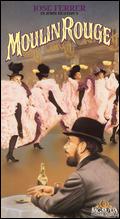 But
perhaps my greatest and
most long lasting
discovery came one wet
Thursday night when we
went to the Empire
and there on the screen
were the paintings and
posters of
Toulouse-Lautrec.
I was deeply affected by Moulin
Rouge
and I have to confess
that I was obviously too
young to see this film.
The effect that it had on
me was pronounced. I was
mesmerized by its
presentation and it was
here that I first saw the
Can-Can!
I cannot stress the
effect that those
screaming, twirling,
whirling danseuses had
on me as they ran yelping
onto the dance floor and
then weaved about the
audience who stood
motionless on the
ballroom floor in utter
amazement. I was
intoxicated by the sheer devil
may care behavior of
the danseuses who
danced with total
disregard and with almost
contempt for their
onlookers. They danced,
they yelped, they
high-kicked top hats off
stuffy heads and they
seemed to be doing it for
their own pleasure. The
smoke filled dancehall,
the hypnotizing colours,
the young Zsa Zsa Gabor
with the sweetest of
singing voices telling me
that It’s April
again and then asking
where
is your heart
were too much for me
to fully take in and I
was lost to the gay
abandon of the gay
nineties. At one
point in the course of
the film, I was obviously
so moved and
jumped up from my seat
and was about to leap
into the aisle.
Obviously, I wanted to
get into the dance.
Fortunately, I was caught
in mid whirl and
returned, with some
impact to my seat, where
I sat exhausted
throughout the rest of
the film. For those that
do not know this film, I
urge you to see it. It
has the most impressive
and spectacular final
scene. I was greatly
taken by the concept of
dying while danseuses cavort
about the deathbed. I
found this to be a stroke
of genius on the part of
the film makers and I
must confess that I would
find this to be the ideal
death and still secretly
hope that my own passing
will take place in this
way. But
perhaps my greatest and
most long lasting
discovery came one wet
Thursday night when we
went to the Empire
and there on the screen
were the paintings and
posters of
Toulouse-Lautrec.
I was deeply affected by Moulin
Rouge
and I have to confess
that I was obviously too
young to see this film.
The effect that it had on
me was pronounced. I was
mesmerized by its
presentation and it was
here that I first saw the
Can-Can!
I cannot stress the
effect that those
screaming, twirling,
whirling danseuses had
on me as they ran yelping
onto the dance floor and
then weaved about the
audience who stood
motionless on the
ballroom floor in utter
amazement. I was
intoxicated by the sheer devil
may care behavior of
the danseuses who
danced with total
disregard and with almost
contempt for their
onlookers. They danced,
they yelped, they
high-kicked top hats off
stuffy heads and they
seemed to be doing it for
their own pleasure. The
smoke filled dancehall,
the hypnotizing colours,
the young Zsa Zsa Gabor
with the sweetest of
singing voices telling me
that It’s April
again and then asking
where
is your heart
were too much for me
to fully take in and I
was lost to the gay
abandon of the gay
nineties. At one
point in the course of
the film, I was obviously
so moved and
jumped up from my seat
and was about to leap
into the aisle.
Obviously, I wanted to
get into the dance.
Fortunately, I was caught
in mid whirl and
returned, with some
impact to my seat, where
I sat exhausted
throughout the rest of
the film. For those that
do not know this film, I
urge you to see it. It
has the most impressive
and spectacular final
scene. I was greatly
taken by the concept of
dying while danseuses cavort
about the deathbed. I
found this to be a stroke
of genius on the part of
the film makers and I
must confess that I would
find this to be the ideal
death and still secretly
hope that my own passing
will take place in this
way.
(In 1954,
a film was released, French
Can-Can,
directed by Jean Renoir
and starring Jean
Gabin. The link
here is to the climatic
sequence of the
dance. Had I seen
this version as a child,
I don't think that anything
could have kept me in my
seat!)
As I said
earlier, the purpose of
this story is to write
about the cinemas of my
area and not of the many
great films that I saw in
them. However, again and
as I have said, upon
recollection of my
memories of the cinemas,
I cannot but recall the
films, since my memories
of each are so
intertwined that they
cannot always be
separated.
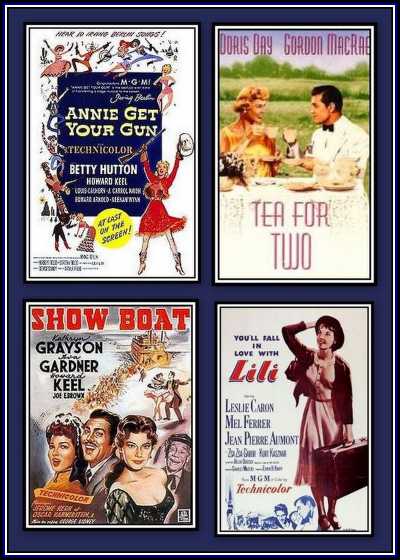 Although
the Empire Mile End was
not my favourite cinema
as a child, it
nonetheless holds a
prominent place in my
memory for it was here
that my first real
exposure into film
took place. I saw my
first western here; my
first period piece here;
and saw for the first
time all kinds of other
film genre here.
It was here that I
learned not only to
expect, but also to be
guaranteed quality whenever
the lion roared! I
also learned to know that
I could trust The
Brothers Warner not
to let me down. Thanks to
those moguls, my
imagination was given
sufficient fodder to
feast on and to develop.
Those early visits to
this cinema set the scene
for me turning into the
lifelong film buff that
I am. Certainly the
majority of films shown
was neither highbrow nor
thought provoking,
but they entertained me,
and at my age then, this
was what was important.
Since I started going to
see films at a very young
age, it is not surprising
that I became totally
immersed in the storyline
– or should I say
the action line
for like most kids, I
found the so-called romantic
interludes to be
tedious and distracting
from the principle theme
of the story. This
reminds of a remark that
I once heard voiced by an
irritated man. We were
watching a film whose
name escapes me, and the
action was evidently
rolling along nicely, and
we were about to seize
the castle or break
out of some prison or
dungeon, when the
hero appeared to forget
the point of the
exercise, and stops
off to woo a damsel who
was not in distress.
Naturally, being young,
it is understandable that
I would not be pleased at
being kept waiting to
storm the battlements,
however a man sitting
close by, obviously as
vexed as me, and with poor
impulse control suddenly
yelled out … blimmin’
kissin’! This
caused a number of
similar minded people,
including me, to offer
verbal support. This was
greeted by a number of
pleas for our silence.
Again my parents were
embarrassed at my
behaviour and I received
a slap on the leg, which
told me to be quiet.
Alas, the pleas for
silence did not have the
desired effect and only
served to bring further
complaints from the man
and his associates.
Before long, an argument
ensued, followed by
threats being made and
finally requests to meet
outside. East Enders
are notorious for
expressing their views,
whether asked for or not.
Unfortunately fellow
audience members either
have to tolerate the
annoyance or be willing
to enter into their own
battle. Quick action on
the part of the manager
most often would bring
about a truce and soon we
would return to following
the action on the screen. Although
the Empire Mile End was
not my favourite cinema
as a child, it
nonetheless holds a
prominent place in my
memory for it was here
that my first real
exposure into film
took place. I saw my
first western here; my
first period piece here;
and saw for the first
time all kinds of other
film genre here.
It was here that I
learned not only to
expect, but also to be
guaranteed quality whenever
the lion roared! I
also learned to know that
I could trust The
Brothers Warner not
to let me down. Thanks to
those moguls, my
imagination was given
sufficient fodder to
feast on and to develop.
Those early visits to
this cinema set the scene
for me turning into the
lifelong film buff that
I am. Certainly the
majority of films shown
was neither highbrow nor
thought provoking,
but they entertained me,
and at my age then, this
was what was important.
Since I started going to
see films at a very young
age, it is not surprising
that I became totally
immersed in the storyline
– or should I say
the action line
for like most kids, I
found the so-called romantic
interludes to be
tedious and distracting
from the principle theme
of the story. This
reminds of a remark that
I once heard voiced by an
irritated man. We were
watching a film whose
name escapes me, and the
action was evidently
rolling along nicely, and
we were about to seize
the castle or break
out of some prison or
dungeon, when the
hero appeared to forget
the point of the
exercise, and stops
off to woo a damsel who
was not in distress.
Naturally, being young,
it is understandable that
I would not be pleased at
being kept waiting to
storm the battlements,
however a man sitting
close by, obviously as
vexed as me, and with poor
impulse control suddenly
yelled out … blimmin’
kissin’! This
caused a number of
similar minded people,
including me, to offer
verbal support. This was
greeted by a number of
pleas for our silence.
Again my parents were
embarrassed at my
behaviour and I received
a slap on the leg, which
told me to be quiet.
Alas, the pleas for
silence did not have the
desired effect and only
served to bring further
complaints from the man
and his associates.
Before long, an argument
ensued, followed by
threats being made and
finally requests to meet
outside. East Enders
are notorious for
expressing their views,
whether asked for or not.
Unfortunately fellow
audience members either
have to tolerate the
annoyance or be willing
to enter into their own
battle. Quick action on
the part of the manager
most often would bring
about a truce and soon we
would return to following
the action on the screen.
 Before
going to the cinema, my
mother would give me a
strict talking to as
to how I was to comport
myself. I was not to jump
up, I was not to call
out and I was not to lash
out in excitement at
those sitting next to me
– my mother and
father. Naturally, I
would promise not to do
any of these things. I
was being brought up to
be a gentleman, and
although I was young, I
was well aware of what
was expected from such a
person. However, once the
action begun, all bets
were off and all
promises were nullified! Since
I always took sides
in the action, I felt
compelled to make known
my allegiance –
again, much to the
embarrassment of my
parents. I was always
loyal and never deserted
my favourites and never
ever switched sides. In
Westerns, I always sided
with the Indians. There
was never any question
here. To me, white men
were the villains and
the Indians were the
honourable ones. No
matter what the Indians
were said to have
done, I still took up
my lance and bow and
followed them. I have to
confess that I did so at
that time not for any
righteous, moral or
political reason, but
purely and simply because
I liked them
best. Do not fail to
underestimate the power
that a chief’s full
headdress has on a child.
And what child would not
wish to align himself
with a screaming,
marauding warrior riding
bareback and at full
pelt across a plain?
To this day, this is
still my ultimate non-political
expression of freedom. Before
going to the cinema, my
mother would give me a
strict talking to as
to how I was to comport
myself. I was not to jump
up, I was not to call
out and I was not to lash
out in excitement at
those sitting next to me
– my mother and
father. Naturally, I
would promise not to do
any of these things. I
was being brought up to
be a gentleman, and
although I was young, I
was well aware of what
was expected from such a
person. However, once the
action begun, all bets
were off and all
promises were nullified! Since
I always took sides
in the action, I felt
compelled to make known
my allegiance –
again, much to the
embarrassment of my
parents. I was always
loyal and never deserted
my favourites and never
ever switched sides. In
Westerns, I always sided
with the Indians. There
was never any question
here. To me, white men
were the villains and
the Indians were the
honourable ones. No
matter what the Indians
were said to have
done, I still took up
my lance and bow and
followed them. I have to
confess that I did so at
that time not for any
righteous, moral or
political reason, but
purely and simply because
I liked them
best. Do not fail to
underestimate the power
that a chief’s full
headdress has on a child.
And what child would not
wish to align himself
with a screaming,
marauding warrior riding
bareback and at full
pelt across a plain?
To this day, this is
still my ultimate non-political
expression of freedom.
Despite
giving my parents
embarrassment when taken
to Westerns, I fear that
this was nothing
to what they had to
suffer when sword
fighting was
involved. Generally my
father would go through
life totally oblivious to
the fact that he was
meant to have a part in
the life of his family.
He was like a traveler
….. just passing
through who would only on
special occasions
remember his
responsibility to us. At
the cinema, my over
zealous behaviour was
normally left to my
mother to control.
However, my leaping
out of my seat during
screen swordplay would
remind my father that I
needed restraining. At
this, he would grab my
collar and physically
lift me back into my
seat. The force of his
action was enough to
bring back to reality.
However, should he feel
that I was offering
resistance, then once
landed in my seat, I
would then feel his hand
come down on my leg.
Although I am sure that
it was not his intention
to smack me hard,
nonetheless he would
deliver a sting that
would generally last
throughout the remainder
of the film and for part
of the walk home. Of
course, had he come
out of his dream
earlier in my life,
perhaps my poor mother
might not have suffered
as much from my over
eager participation in
action on the screen and
perhaps I should not have
suffered the sting.
When I
think of the Empire
Mile End, I cannot
but remember the
wonderful films seen
there. I will once more
indulge myself with a
remembrance of one final
film seen here. And
again, hindsight has led
me to conclude that I was
far too young to see this
film. Without doubt I was
too young to appreciate
that what I saw at times
on the screen was not
always a reflection
reality. At that age I
believed almost
everything that I saw on
the screen and was guilty
of taking what I saw
literally. With that
said, it is not
surprising to learn that
my misinterpretations
often had a pronounced
effect of my
understanding of the film
and on me personally. My
complete
misinterpretation of the
film of Offenbach’s The
Tales of Hoffman is
one such example. This
masterpiece, directed by
the same team responsible
for The Red Shoes,
Emeric Pressburger and
Michael Powell, were
people known for their
surreal approach to film.
However, whether too
young or not, once I had
set my mind on seeing a
film, I was able to
convince my parents of
its importance and
so get my way. Even at my
young age, I fear that I
was not too young to talk
at length about something
and I was always able to
talk of the merits of
something as important as
a film that I wanted to
see. My poor parents
would generally listen to
my completely made up reviews
and would soon be
wanting to see the
film themselves. I was
brought up to express my
opinion and learned to be
persuasive early in my
life.
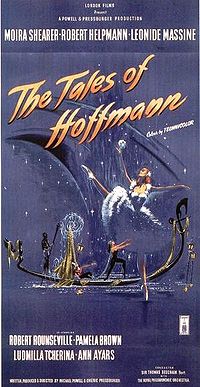 I
remember seeing this
enormous advertisement
for The Tales of
Hoffman high above
Coventry Street in the
West End. I believe that
the film was playing at
the Rialto cinema.
There it was, this
amazing scene: I was
immediately captivated by
a woman standing on the
toes of one foot in the
middle of a boat and with
her other leg extended
out behind her. I
remember wondering why
this scene was being used
to advertise a film.
Surely standing in this
manner would cause the
boat to tip over and send
her and anything else in
the boat crashing into
the water. At my age then
I was prone to take
things literally and not
appreciate the abstract
or the surreal. I
remember causing my
parents to stop and look
at the advertisement and
asking them for an
explanation for her
stability on the water.
It was carefully
explained to me that what
I saw was a painting and
was in fact the result of
the artist’s
imagination. In other
words, it was not real.
This might have been
true, but it did not
satisfy me. After this, I
was plagued by this
advertisement, as it
began to appear in the
newspapers. I remember
studying it at length. I
also remember trying to
stand in the manner of
the woman on one foot and
with the other leg
extended back. Once I got
up onto my toes, I would
generally fall over.
There was only one thing
left to do. I became
determined to see the
film and check out how
this woman stood, on tip
toes, in a moving boat
without falling into the
water. I had come to
admire her since I could
not manage the pose
on dry land, let alone on
water. Of course, I have
to add that at that time
I had not been subjected
to ballet. I
remember seeing this
enormous advertisement
for The Tales of
Hoffman high above
Coventry Street in the
West End. I believe that
the film was playing at
the Rialto cinema.
There it was, this
amazing scene: I was
immediately captivated by
a woman standing on the
toes of one foot in the
middle of a boat and with
her other leg extended
out behind her. I
remember wondering why
this scene was being used
to advertise a film.
Surely standing in this
manner would cause the
boat to tip over and send
her and anything else in
the boat crashing into
the water. At my age then
I was prone to take
things literally and not
appreciate the abstract
or the surreal. I
remember causing my
parents to stop and look
at the advertisement and
asking them for an
explanation for her
stability on the water.
It was carefully
explained to me that what
I saw was a painting and
was in fact the result of
the artist’s
imagination. In other
words, it was not real.
This might have been
true, but it did not
satisfy me. After this, I
was plagued by this
advertisement, as it
began to appear in the
newspapers. I remember
studying it at length. I
also remember trying to
stand in the manner of
the woman on one foot and
with the other leg
extended back. Once I got
up onto my toes, I would
generally fall over.
There was only one thing
left to do. I became
determined to see the
film and check out how
this woman stood, on tip
toes, in a moving boat
without falling into the
water. I had come to
admire her since I could
not manage the pose
on dry land, let alone on
water. Of course, I have
to add that at that time
I had not been subjected
to ballet.
If my
memory serves me well
here, The Tales of
Hoffman took an
absolute age to pass
through its showcase
run in the West End
and then pass through its
pre-general release
presentations before, at
long last going on general
release. At that
time, films would be
shown in North West London
before they came to North
East London where I
lived. I have always
disliked North West London.
I have no reason to do so
other than the fact that
they were privileged in
getting films one week
before me. Mind you, when
I think about it, such an
affront as this is more
than sufficient to sow
the seed of dislike and
qualify as reason for the
holding of a life-long
grudge! Anyway,
eventually the film
arrived at the Empire
Mile End and – surprise
surprise – we
set off to see it on the
Thursday night.
On that
night, I feel certain
that we covered the
distance from the shop to
the cinema in a world
record time. The film was
the most unusual film
that I had seen until
then. It was filled with
the most amazing scenes
that were inexplicable to
me. In one scene, I
remember a woman wearing
a necklace of dark
stones. Quiet suddenly,
and presumably as a
result of her incurring
her companion’s
wrath, at the wave of his
hand, the stones turned
to ribbons. To confuse me
further, people kept
appearing and reappearing
later in different roles.
Not that this is
surprising or hard to
understand, but at my
young age, I was not
aware that the story-line
involved the telling of
several different Tales.
I was used to one tale
where everyone played one
role and did not change
mid way through the story
and where precious stones
were not turned into
ribbons. I was not
especially impressed with
what I was seeing and
probably was getting
quite annoyed that here I
was wasting a precious
Thursday night watching
such incomprehensible
material. And then it
happened! Suddenly the
cinema became filled with
this
remarkable music.
It was a music that I had
never heard before. And
just as suddenly, there
on the screen was a boat
moving slowly across
still dark water –
the boat was a gondola,
but I had no idea what a gondola
was at that time –
and in the centre of it,
posed as she was in the
advertisement, on tip
toes, stood that
beautiful woman. She
stood motionless as the
boat glided slowly over
the still water. It was a
breathtaking site and one
that had a marked effect
on me. I am told that I gasped
at the site and stood up
and had to be restrained
once more and was brought
down into my seat.
Whether I was slapped,
and by whom, I cannot
recall. Being totally
mesmerized by the sight
of this goddess, I
was unaware of my
surroundings. I sat in a
dream-like trance
throughout the remainder
of the film. I have
remembered that film, and
especially that scene,
ever since. Although I
soon found the Barcarolle
to be overly romantic and
it soon fell out of
favour with me. Despite
this, I still retain a
soft spot for the piece
and who can blame me for
that? However, I am only
tolerant of certain
interpretations: although
I liked Elvis, I was
never able to appreciate
his version of this almost
sacred piece.
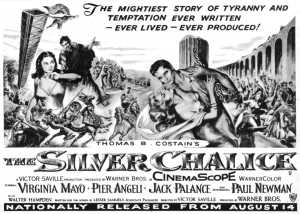 The
very last film that I saw
there was unfortunately
forgettable. It was Paul
Newman’s first film,
The Silver Chalice
– another film with
surrealistic overtones,
but sadly less memorable.
I would have liked my
last film seen there to
have been spectacular,
but it wasn’t. The
very last film that I saw
there was unfortunately
forgettable. It was Paul
Newman’s first film,
The Silver Chalice
– another film with
surrealistic overtones,
but sadly less memorable.
I would have liked my
last film seen there to
have been spectacular,
but it wasn’t.
In
September 1973, as a
result of the changing
times, the Empire Mile
End was tripled and
the décor was changed.
In 1986, it was purchased
by Cannon Cinemas and
renamed. It next passed
through a number of
incarnations and closed
in March 1989. It lay
derelict for over ten
years and I suspect it
must have risked
demolition however the
building was saved by the
purchase by a private
owner. Following the
purchase, a massive
renovation and conversion
into a five-screen
multiplex was undertaken
with every attempt being
made to save as much of
the original design of
the building as possible.
The cinema, now enjoying
life as the Genesis,
opened on 5th
May, 1999. I am pleased
to know that the one-time
Empire still
functions in the capacity
intended by the original
owners and architects.
When I
visit England, I
sometimes go to Whitechapel
and walk along Mile
End Road. I marvel still
at the alms houses with
the ships atop the gates
and sadly note the
further decline of the
fine building that once
was Wickham’s.
I also stop and look at
the advertisements
outside the Genesis.
Sadly, I notice that the
current crop of popular
films gets less and
less appealing to me, but
no matter, they were not
made for my pleasure. I
see the couples and
families and individuals
buying their tickets to
go in and I remember my
excitement each time I
went to the Empire
and I hope that they have
an enjoyable time too.
We would
only go on rare occasions
to the Odeon Hackney
Road since it was a
lot further from our home
than the Empire.
My parents liked this
cinema very much since it
was gloriously decorated
and very comfortable
compared to most of the
cinemas in the area. As I
have said before, when
you went to an Odeon,
you felt a sense of
occasion. The staff
was always courteous and
made patrons feel
welcome. It soon became
one of my favourite
cinemas ever and
the first real Odeon that
I visited. I liked very
much the chocolate and
gold colours used to
decorate the cinema.
The Odeon
Hackney Road opened
on 27th July,
1938 and was the 124th
of the original Odeon cinemas
of Oscar Deutsch and was
designed by Andrew
Mather. The cinema had a
seating capacity of 1,260
in the stalls and 666 in
the circle.
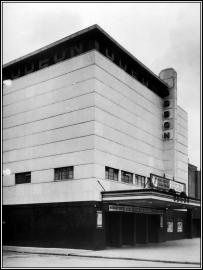
Odeon,
Hackney |
|
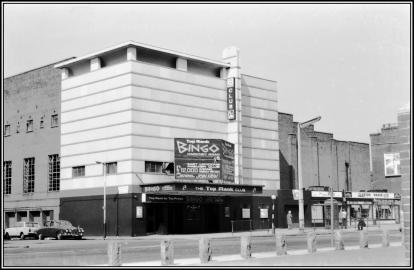
Top
Rank Club |
The
exterior and the
auditorium are not
considered especially
remarkable according to those
that know about these
things. I disagreed
with this viewpoint to
some extent, although I
will admit that the
exterior of the building
was plain, but I found
the interior to be
interesting. I must admit
that perhaps hindsight is
causing me to see the
interior of the Odeon
Hackney more as I
wanted it to be – a
marvel in art deco
– rather than as it
was. Still, I feel
certain that the ornate
grills that graced each
side of the auditorium
and served to cover the
exhaust fans used to
maintain good air in the
cinema were nothing short
of remarkable. I also
feel certain that the
presence of the Odeon clocks
gave that final touch of
elegance to the
auditorium and foyer. I
remember the regret that
I felt when it closed and
was greatly affected by
it.
I always
thought that the Odeon
Hackney Road closed
in 1958, but I am assured
that it occurred on 20th
May, 1961. Although I was
well aware that cinema
ticket sales had declined
markedly with the advent
of television and in
particular with the
success of independent
television, I was not
prepared for the
repercussions. It had not
entered my head that
cinemas would actually
close.
On 6th
November, 1956, we moved
from Bethnal Green to
Langley in
Buckinghamshire. This was
certainly not to my
liking and I missed the
East End very much.
Although Langley was
nice, I found it hard to
settle and I would take
every opportunity to go
to the East End for a
visit, but my visits were
rare since in those days,
the distance from my new
home to Bethnal Green was
far and the cost of a bus
or train ticket
prohibitive to a youth.
However, I would save up
my pocket money and I
would escape the countryside
for the dirt and
grime of my old haunts
whenever I could. During
one visit, I got on a
trolleybus, number 555,
at Liverpool Street
Station en route
to Hackney since I wanted
to go along the Hackney
Road for olde
tyme’s sake. I
noticed with some
concern, as we passed the
Odeon that it was
closed. I had read that
some cinemas in London
were closing, as well as
others elsewhere due to
falling ticket sales.
However, never in my
wildest dreams did I
think that such a
misfortune could ever
befall any of the cinemas
in my part of the East
End. I was horrified. I
could not believe that
such a wonderful place as
the Odeon Hackney had
been forced to close. It
was unthinkable –
and yet it had happened.
How had this been allowed
to happen? Why
hadn’t the people of
the area gone to save it?
I remember
sitting on the top deck
of the trolleybus and
being in my daze. My
fellow companions were a
few young men of working
age on the bus. They were
in jolly mood, as they
smoked their cigarettes
and joked with each
other. They each had
their hair cut short in
the current fashion and
were dressed in new suits
that buttoned up high at
the front. This look
was known as the
Italian look and was all
the rage at the time.
I remember that one
of the group started to
whistle Tea
for Two Cha Cha,
which was a hit at the
time by Tommy Dorsey and
his Orchestra. Soon they
were whistling in unison.
Had I been more myself,
I would have joined
in, but I could not. At
that time, the radio and
newspapers were full of
reports that the Cha
Cha Cha was the
latest craze and
would soon be sweeping
the country as we
danced to its rhythm. In
addition, the reports
mockingly stated that
therefore it would not be
long before rock
‘n’ roll was on
its last legs and
could be buried!
Suddenly, it all proved
too much for me. I saw
that dark black rain
cloud of misery and gloom
install itself above my
head and I felt myself
begin to slip further and
further down into that
bottomless pit of
despair. The combination
of rock being about to
die and the closure
of the Odeon caused
my mood to be melancholy
and I knew that my
feeling of hopelessness
would not pass anytime
soon. Along with my
whistling companions, I
somehow managed to get
off the trolleybus in
Hackney. Obviously I must
have planned to re-visit the
Hackney, but
understandably by this
time my heart was no
longer in it. All
I wanted to do was to go
home and tell my parents
of the terrible news. I
felt the need to share the
loss and to be with
people who would
understand. Naturally
every time I hear Tea
for Two Cha Cha, I
still feel a certain
sadness. I also have to
remind myself that the Cha
Cha Cha did not
herald the demise of rock
after all. I have
learned that in life one
has to take consolation
from wherever one can.
As it
happens, things could
have been worse. What I
thought was bringing only
gloom, as it turns out,
brought a kind of
salvation for the Odeon
Hackney did not
suffer the same fate as
many other cinemas. As
tragic as it was that it
closed as a cinema, it
was not demolished and
immediately became a Top
Rank Bingo Hall.
Although I saw the use of
such a majestic building
for the purpose of
playing Housey Housey for
money as an insult to the
memory of the one-time
much loved cinema, it was
this that saved it from
the wrecking ball. Today,
despite passing to
different owners and now
having a less than
impressive exterior, the
building still flourishes
as a Mecca Bingo Hall.
In fact the one-time Odeon
Hackney has
functioned as a Bingo
Hall for a longer
period of time than ever
it did as a cinema. I
have learned that one
cannot have everything in
life and that one has to
accept even the smallest
of victories with good
grace.
The other ABC
of the area, the Regal,
was in Hackney at the
corner of the
intersection of Mare and
Well Streets. It opened
in 1936 with William R.
Glen as architect. The
cinema was a typical art
deco ABC cinema,
large and cavernous and
with a decorative foyer
and auditorium.
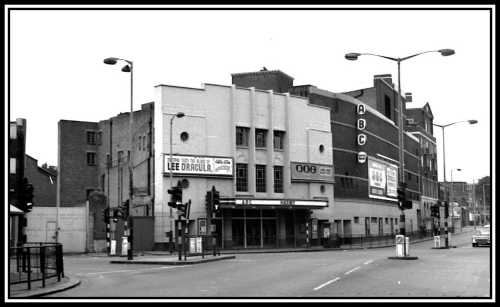
ABC
Regal, Hackney
I only
went there a few times
and as impressive as the
décor was, the place
seemed cold and
lacked the intimacy
offered by some of the
other less elegant
cinemas of the area. The
first film that I saw
there was The
Prodigal. I had gone
to see it purely and
simply because, at the
time, I had a lusting for
Lana Turner. I remember
that Robbie the Robot stood
motionless in the foyer
at the time. I was not
impressed by him, I am
sorry to say. At the
time, I was not
interested in Science
Fiction. It would
take many years, before
this would happen.
The
last film that I saw at
the Regal was
called A Question of
Adultery and was
absolute rubbish. I
remember that I had
accompanied my mother on
a trip to see my
grandmother who was
living in London Fields
at the time. I was happy
to do this as it meant
that I could miss school.
Mercifully, after a short
time in my
grandmother’s home,
I was allowed to escape
and leave my mother and
grandmother together
while I went to the
pictures. I remember
going to see this film
purely and simply because
it had been given an X
certificate, which
meant that no one
under the age of 16 would
be allowed entry to the
cinema. It was only
natural for all kids who
were under age to
want to try to get in
to any film given such a
certificate since it was
believed that there were
going to some juicy
bits in it that would
titillate a young
gentleman. Some hopes with
that boring film! Anyway,
since I was about 14
years old at the time, I
was very pleased and felt
very grown up when I got
into the cinema without
being questioned about my
age.
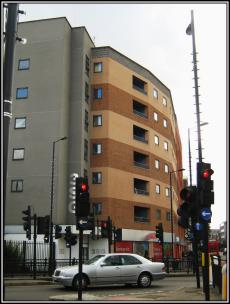 The
Regal Hackney was
closed in 1981 and like
so many other cinemas
became a Snooker Hall.
The game had become very
popular due to BBC
2 coverage in the
1970s and many old
cinemas were incarnated
as halls. However, this
new life was short lived
and the building was soon
closed permanently. It
was eventually demolished
in 1998 and an Iceland
food store now
occupies its site. What
is interesting about this
store is that the new
building still follows
the original sweep about
the corner of the
intersection of Mare and
Well Streets, which I
find rather elegant and
respectful of the owners.
It is in keeping,
and in a way charming
that they should pay
homage to the
important building that
once occupied the site. The
Regal Hackney was
closed in 1981 and like
so many other cinemas
became a Snooker Hall.
The game had become very
popular due to BBC
2 coverage in the
1970s and many old
cinemas were incarnated
as halls. However, this
new life was short lived
and the building was soon
closed permanently. It
was eventually demolished
in 1998 and an Iceland
food store now
occupies its site. What
is interesting about this
store is that the new
building still follows
the original sweep about
the corner of the
intersection of Mare and
Well Streets, which I
find rather elegant and
respectful of the owners.
It is in keeping,
and in a way charming
that they should pay
homage to the
important building that
once occupied the site.
As with
the Odeon Hackney,
the Odeon Mile End was
one of Oscar
Deutsch’s original Odeons
and opened on 17th
October, 1938. It was
designed by Andrew Mather
and featured a
distinctive Odeon style
tower. Unfortunately, I
never went inside since I
had no reason to, as
there were two other Odeons
closer to our home
should we which to enjoy
a film on general release
on this circuit. I truly
regret this since judging
by the pictures that I
have seen, as the
auditorium was both
interesting and
attractive with large
decorative painted floral
panels on the side walls
close to the proscenium.
Despite extensively
remodeled in 1968, as
ticket sales fell, the
cinema was eventually
closed in June 1972. It
reopened as the
Sundown Venture in
September 1972, but was
closed once more in
January 1973. It remained
closed until 1975 when it
reopened briefly as a
cinema specializing in Bollywood
films. However,
eventually it eventually
closed permanently in
1978 and sat empty until
it was demolished in May
1984 to make way for an
office and residential
block.
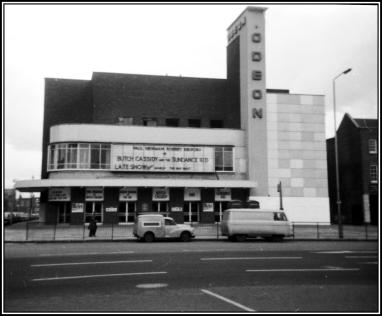
Odeon
Mile End - exterior |
|
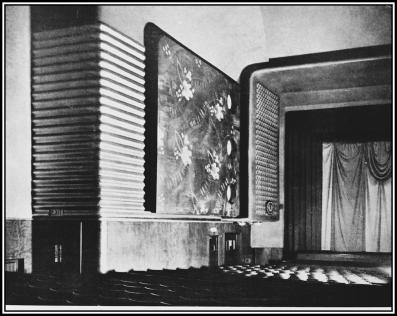
Odeon
Mile End - interior |
According
to my classification of
the cinemas in my area of
the East End, I now come
to those cinemas thought
of as good ones.
There were two: the Excelsior
Bethnal Green and the
Foresters Cambridge
Heath Road. I will
not talk about the Excelsior
here, but will return
to it later.
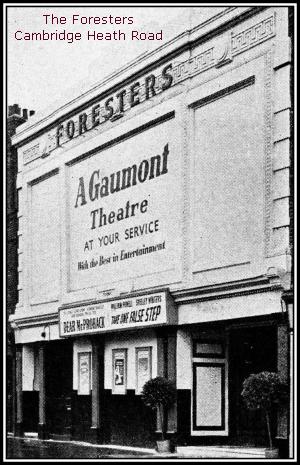 The
Foresters cinema
was practically our
next door neighbour since
it was a mere quarter of
a mile further down
Cambridge Heath Road from
my parents’ shop.
Despite its proximity, I
rarely went there. It
originally opened as a
hall attached to the Artichoke
Public House in 1825
and was converted to the Foresters
Music Hall in 1889.
In 1912, films began to
be screened at the cinema
and did so until 1917,
when it closed and
remained so until 1926.
It re-opened as the Foresters
Super Cinema after
extensive alterations and
had a seating capacity of
674 in the stalls and 383
in the balcony. In June
1937, the cinema was
taken over by Odeon.
It suffered damage during
the war and was closed
for restoration between
April 1947 and October
1949. Once the cinema was
re-opened, it screened
the same films as the Gaumont
circuit, however
it was never owned by Gaumont.
The Foresters closed
permanently in August
1960 and remained
unoccupied until 1964
when it was demolished
and replaced by a block
of flats. The
Foresters cinema
was practically our
next door neighbour since
it was a mere quarter of
a mile further down
Cambridge Heath Road from
my parents’ shop.
Despite its proximity, I
rarely went there. It
originally opened as a
hall attached to the Artichoke
Public House in 1825
and was converted to the Foresters
Music Hall in 1889.
In 1912, films began to
be screened at the cinema
and did so until 1917,
when it closed and
remained so until 1926.
It re-opened as the Foresters
Super Cinema after
extensive alterations and
had a seating capacity of
674 in the stalls and 383
in the balcony. In June
1937, the cinema was
taken over by Odeon.
It suffered damage during
the war and was closed
for restoration between
April 1947 and October
1949. Once the cinema was
re-opened, it screened
the same films as the Gaumont
circuit, however
it was never owned by Gaumont.
The Foresters closed
permanently in August
1960 and remained
unoccupied until 1964
when it was demolished
and replaced by a block
of flats.
It is hard
to understand why I went
to this cinema so rarely
and why I should never
went there with my
parents. The main reason
for this must have been
that the presentations
offered here must have
been less appealing than
those showing at the Empire
Mile End, which was
where we usually went.
Of interest also is
that although this cinema
showed the same films as
the Excelsior Bethnal
Green, which was
about a mile and a half
from our shop and just
off Bethnal Green Road,
my mother would always
choose to go there rather
than to the Foresters.
Since I liked the Excelsior
too and held it in high
esteem, I never
questioned this decision.
The
exterior of the Foresters
was decidedly
unremarkable and little
was made of it in order
to attract patrons. The
front had a large area
that cried out for
decoration, but the
best that the management
could do with it was to
have the name of the
cinema across the top and
tell us that the cinema
was a Gaumont
and at your service and
was the best place to
come for entertainment.
Below this was a
billboard with the
week’s films pasted
onto it. There were
several windows for posters
at ground floor level
and there was always a
potted shrub close to the
entrance, which was
generally chained down. I
remember the box office
was close to the entrance
doors and following the
purchase of a ticket,
patrons walked along a
corridor and entered the
auditorium by passing
through a curtain. Around
three both sides of the
auditorium were elevated
open boxes, a
style reminiscent of the
seating plan common to Music
Hall. I cannot say
that I went to this
cinema more than half a
dozen times, if that, and
have no memory of the
décor or of its comfort.
What I can remember of it
was that it did not have
a large auditorium and
that it was quite narrow.
The only films that I can
remember seeing there
were The Prince who
was a Thief, The
Desert Song and Peter
Pan.
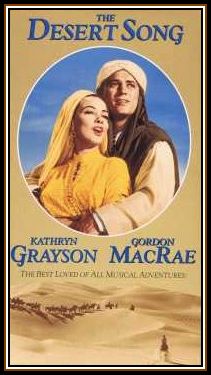 I
had absolutely no
intention of seeing The
Desert Song, and it
is quite curious how I
came to see it. I
remember that my mother
accompanied me to the
cinema and was in a
somewhat agitated state.
I was not very old at the
time and was surprised
that I was going to the
cinema without having
to ask and was being
allowed to go at such a
late hour. I should have
realized that something
was up, as these
events were far from
normal. Whenever I went
to the pictures
without my parents, I was
never accompanied to the
door by a parent.
This would have been
potentially humiliating
since one could have been
seen by one’s
friends. I
had absolutely no
intention of seeing The
Desert Song, and it
is quite curious how I
came to see it. I
remember that my mother
accompanied me to the
cinema and was in a
somewhat agitated state.
I was not very old at the
time and was surprised
that I was going to the
cinema without having
to ask and was being
allowed to go at such a
late hour. I should have
realized that something
was up, as these
events were far from
normal. Whenever I went
to the pictures
without my parents, I was
never accompanied to the
door by a parent.
This would have been
potentially humiliating
since one could have been
seen by one’s
friends.
After my
mother paid for my
ticket, she asked an
usherette to keep an
eye on me. The
usherette led me into the
auditorium and I was
given a seat in the expensive
seats. The usherette
kept her word and an
eye on me as asked.
After the film ended, the
usherette said that she
would walk me up to the
shop. I remember thinking
that she was very pretty
and was quite taken with
her. When I got home, I
found the shop closed and
my mother waiting alone
for me in the shop. This
was truly remarkable,
because normally at that
time, the shop would be
full of folks enjoying a
late snack. I remember
that my mother looked
tired and upset. She said
that my father had been taken
ill and was now in
bed and that I had to be
quiet when going
upstairs.
Taken
ill is a euphemism
for drunk! Later I
learned that my parents
had had a row earlier in
the day, and as was
typical of my father, had
run off and solved
his problem by getting
drunk. My father, like Blanche
du Bois, was the kind
of person who relied
on the generosity of strangers
and had been brought home
after passing out
outside the pub.
As my mother would put it
in old East End parlance
…. it was either
this or else the basket!
In
Victorian and Edwardian
times, and to a lesser
extent, during my
childhood, when someone
got drunk and passed out,
unless their companions
could get them home, the
police would be called to
take care of them.
In those days, taking
care meant bringing
out the basket.
The thought of the
basket was enough to
make the most
stout-hearted turn pale
and would be certain to
bring shame to the
family. My mother’s
stepfather was a very big
drinker and was generally
drunk. Most of the time,
he was able to get home
with only minor
skirmishes with
passersby. He was
apparently a robust man
and capable of holding
his own during encounters
with the police. In those
days, policemen were also
robust and not
faint-hearted. They
carried no weapons other
than small truncheons,
but generally they could take
care of abusers of
the law without need of
them. According to my
grandmother, my
step-grandfather once put
six large policemen into
a nearby horse trough
filed with water while in
a drunken rage. Following
this, he is said to have
passed out requiring him
to be brought to the police
station in the
basket.
The
basket was a large
whicker chaise longue
on wheels. The disabled
was lain on the chaise
longue ensuring that
the head was raised and
then one or two policemen
would wheel the
infirmed through the
streets to the station.
Although family members
would feel shame at the
thought of their loved
one being drunk and
passing out in public,
this was considered nothing
compared to the shame
and humiliation
they would experience
should the loved one
require wheeling through
the streets in the
basket.
Apparently
my father had passed out
on the street outside a
pub. Luckily, he was well
known to the landlord
of the pub. This
was fortunate for him,
since the landlord
allowed him to be brought
into the pub and
out of the way of the
prying eyes of the
police. Had the police
found him first, then it
would have been the
basket for him and
further shame for
us. The landlord
telephoned my mother at
the shop to give her the
news and in order to
spare me from seeing my
father in a such a
state, I was sent off
to the pictures
while my poor mother was
left to clear up the
mess alone.
Sadly over the years, my
mother was not able to
shield me from such
events and soon, we were
sharing the humiliation
together.
There were
four passable cinemas
in the area: the
Essoldo Bethnal Green,
the
Empress Hackney,
the Hackney Pavilion and
the Mayfair Brick Lane.
I will not talk about the
Essoldo and the Empress
here since despite their
seemingly lowly status by
classification, they held
a very special place in
my memory, which I will
discuss later.
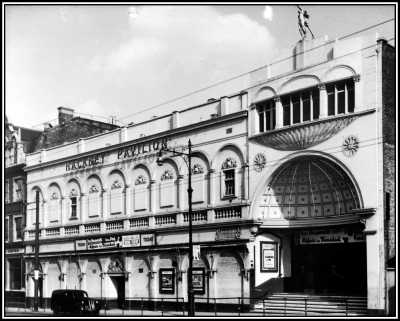 The
Hackney Pavilion
was on Mare Street on the
other side of the road
and almost directly
across from the
Hackney Empire. It
was opened in May 1914
and had 1,500 seats. In
April 1928 it was taken
over by PCT and by
the time it closed on 22nd
January, 1972, it had a
seating capacity had been
reduced to 1,117. At the
time of closure, the
cinema was part of the Gaumont
Circuit. It was later
demolished and the site
was used for a branch of Barclay’s
Bank. By the time I
became aware of the Pavilion,
it had seen better
days and was not in
an especially good state.
Despite this, it was
possible to see that the
cinema must have been an
attractive building at
one time, since it had
retained its interesting
exterior and entrance
area complete with steps
and a small capula decorated
with terracotta tiles. The
Hackney Pavilion
was on Mare Street on the
other side of the road
and almost directly
across from the
Hackney Empire. It
was opened in May 1914
and had 1,500 seats. In
April 1928 it was taken
over by PCT and by
the time it closed on 22nd
January, 1972, it had a
seating capacity had been
reduced to 1,117. At the
time of closure, the
cinema was part of the Gaumont
Circuit. It was later
demolished and the site
was used for a branch of Barclay’s
Bank. By the time I
became aware of the Pavilion,
it had seen better
days and was not in
an especially good state.
Despite this, it was
possible to see that the
cinema must have been an
attractive building at
one time, since it had
retained its interesting
exterior and entrance
area complete with steps
and a small capula decorated
with terracotta tiles.
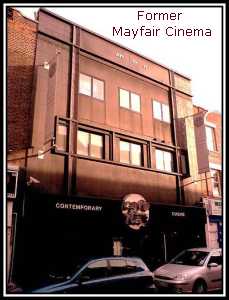 The
Mayfair Brick Lane opened
in January 1936 and was
built on the site of the Brick
Lane Palace and was
acquired by Eastern
Cinemas in 1937. The
cinema became part of General
Cinemas Financing, which
in turn merged with Odeon
Theatres Limited in
1943. I remember that the
façade was flat and of
white and yellow with the
name of the cinema across
the top. As with the Foresters
Cambridge Heath Road, the
current features were
advertised above the
entrance doors. I never
visited the cinema, but I
do remember some of my
classmates that lived in
this area saying that it
was not bad – to
us kids, this was
a reasonable
recommendation especially
when I think of what they
might have said. I was
told that the auditorium
consisted of stalls and
balcony with a seating
capacity of 1,500 and
that the décor was in
the art deco
style. The cinema closed
in July 1967 and was sold
to an independent company
who reopened it soon
after and used it to
screen Bollywood films.
It later closed
permanently as a cinema
and was then used as a
store and indoor car park.
In the 1990s, the
building was demolished
and replaced with a block
of flats and a
restaurant. The
Mayfair Brick Lane opened
in January 1936 and was
built on the site of the Brick
Lane Palace and was
acquired by Eastern
Cinemas in 1937. The
cinema became part of General
Cinemas Financing, which
in turn merged with Odeon
Theatres Limited in
1943. I remember that the
façade was flat and of
white and yellow with the
name of the cinema across
the top. As with the Foresters
Cambridge Heath Road, the
current features were
advertised above the
entrance doors. I never
visited the cinema, but I
do remember some of my
classmates that lived in
this area saying that it
was not bad – to
us kids, this was
a reasonable
recommendation especially
when I think of what they
might have said. I was
told that the auditorium
consisted of stalls and
balcony with a seating
capacity of 1,500 and
that the décor was in
the art deco
style. The cinema closed
in July 1967 and was sold
to an independent company
who reopened it soon
after and used it to
screen Bollywood films.
It later closed
permanently as a cinema
and was then used as a
store and indoor car park.
In the 1990s, the
building was demolished
and replaced with a block
of flats and a
restaurant.
Tragically,
we now come to the
cinemas classified as dumps.
As I have said, dumps and
fleapits are harsh
terms and somewhat
unfair. Be that as it
may, I classify these
cinemas based on their look,
charm and comfort.
Sadly, the Museum
Bethnal Green, the Standard
London Fields and the
Palaseum Commercial Road easily
fell into this category.
 According
to the records, an
application to build a
cinema in Cambridge Road
was made in 1910 and
again in 1913 by the Bethnal
Green Cinema Company. The
original cinema that was
built on the site had a
seating capacity of 500
and was named the Museum,
after the nearby Bethnal
Green Museum or the Museum
of Childhood as it
likes to be called now.
Be that as it may, the
original cinema underwent
reconstruction in 1931
and the remodeled
building then had a
seating capacity of 802.
The Museum was
apparently renamed the Odeon
in 1950, but I never
heard anyone call it by
that name. It was always
the Museum or else
some derogatory term was
used. Regardless of its
name, it closed in 1956
and was replaced by a
building consisting of
office space and a launderette
where the auditorium once
was. The launderette has
since been closed and
left derelict with whitewash
on the inside of the
windows. According
to the records, an
application to build a
cinema in Cambridge Road
was made in 1910 and
again in 1913 by the Bethnal
Green Cinema Company. The
original cinema that was
built on the site had a
seating capacity of 500
and was named the Museum,
after the nearby Bethnal
Green Museum or the Museum
of Childhood as it
likes to be called now.
Be that as it may, the
original cinema underwent
reconstruction in 1931
and the remodeled
building then had a
seating capacity of 802.
The Museum was
apparently renamed the Odeon
in 1950, but I never
heard anyone call it by
that name. It was always
the Museum or else
some derogatory term was
used. Regardless of its
name, it closed in 1956
and was replaced by a
building consisting of
office space and a launderette
where the auditorium once
was. The launderette has
since been closed and
left derelict with whitewash
on the inside of the
windows.
It grieves
me to say that the Museum
Bethnal Green,
although part of the Odeon
circuit, must surely
have been the worst of
all their cinemas. It was
a truly unattractive
cinema and I doubt if it
ever had seen better
days by the time I
knew it. The
cinema appeared small to
me – very small
– and had no circle
and was totally devoid of
charm and comfort.
According to those
that know, the
auditorium was said to be
thirty feet wide. I find
this hard to believe, but
I am most likely
prejudiced against the
place! The auditorium had
little if any decoration
on the walls. Nothing
about the place was
inviting. I have recently
learned that the poor
place was never fitted to
show films in CinemaScope!
Obviously, I was not
alone in finding the
cinema to be without
merit.
My mother
disliked the cinema very
much and would only go
there if she really
wanted to see a
particular film and did
not want to travel the
extra distance and go to
the Odeon Hackney.
I went to this cinema
perhaps three times in
all. I remember seeing Gentlemen
Prefer Blondes and Walt
Disney’s Alice in
Wonderland here. The
third film was a really
silly film called It
grows on trees. This
referred to money and,
as young as I was, even I
could tell that this film
was total rubbish. I
remember the film quite
clearly since my mother
was in hospital just a
little further up the
road in the Bethnal
Green Hospital at the
time, and I was not
allowed to visit here.
Those were the rules in
those days. No children
were allowed onto adult
wards. My mother spent
six weeks in hospital.
Thanks to the kindness of
the sister-in-charge, I
was allowed into the
central court of the
garden each Sunday
afternoon for a few
minutes. My mother would
come to the window of the
kitchen on her ward and
we would waive to each
other. We would both weep
copious tears. I remember
being was miserable
during that time. Is it
any wonder that I did not
enjoy the film!
Although
the Standard was
considered to be in
London Fields, it was
found about two hundred
yards along
Goldsmith’s Row off
Hackney Road, and one
would think that it would
be in either Bethnal
Green or Hackney. But
division of London
Boroughs is decided upon
by Town and Country
Planners and not by
people like me –
hence it being considered
in London Fields. The
cinema first opened in
1911 and was originally
called the Electric
Cinema. This name was
quickly changed to the Olympia
Cinema and was
changed yet again in 1912
to the Standard.
The façade was re-built
in 1927 and again in 1935
when it was given an art
deco façade. The
original seating capacity
was 882, but was
increased in 1935 was
increased to 1,153. The Standard
closed as a cinema in
1960 and became a bingo
club. Later, it became a
snooker club and remained
so for a number of years.
In August 2006, the
building was demolished.
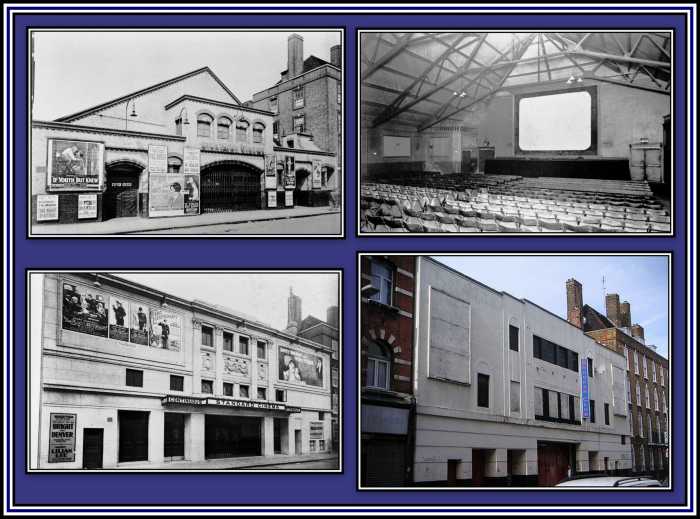
The
Standard, London Fields
This
cinema was part of the Granada
circuit and did not
show very interesting
films until Granada began
to show the films
produced by 20th
Century Fox. When I
knew this cinema, like
the Hackney Pavilion,
it had decidedly seen better
days. I never visited
this cinema so cannot
comment on its interior
and décor. I do remember
that the exterior was not
especially attractive and
I can recall no special
features of it.
Photographs definitely
reveal it to have been an
attractive building, but
war and neglect brought
about its decline.
One of the
roads that form the
intersection known as
Mile End Gate is Sydney
Street and it was along
this street that the
infamous Sydney Street
Seige took place.
Sydney Street connects
Whitechapel/Mile End Road
with the Commercial Road.
Across Commercial Road,
almost adjacent to Sydney
Street, was the site of
the Palaseum
Commercial Road. Like
the Hackney Pavilion, the
Museum Bethnal Green
and the Standard
London Fields, it had
seen better days. I never
visited the cinema since
the time I saw it, the
poor place was in a
sorry state and was
totally lacking in charm.
I used have a friend who
lived on Anthony Street,
which was one of the
streets adjacent to where
the cinema once was. I
remember his telling me
that it was not
especially interesting
inside – these are
my words and not his, by
the way – his were
more colourful.
Apparently
the Palaseum was
first opened as Fineman’s
Yiddish Theatre on
2nd December,
1912 and seated 1,000
patrons. It was later
taken over by United
Pictures Theatres and
then by Gaumont
management, as part
of the UPT circuit.
In 1934, it became part
of the ABC/Regent
Circuit and had a
seating capacity of 920
at that time. The cinema
next passed to the
control of Southan
Morris in 1949 and
then by Essoldo in
1954. It closed on 19th
March, 1960, but reopened
on 18th
October, 1961 as the Essoldo
and closed once more in
September 1966. It later
reopened as the Palaseum
and showed Asian
films until 1985.
In October of that year,
it was closed and
demolished to make way
for the re-positioned Watney
Market. Judging
from pictures taken
before the war, it was
once an attractive
building and I regret not
having had the
opportunity to see it in
its prime.
Although
not strictly in my area,
the Troxy found
further along the
Commercial Road, was
certainly the most glamorous
of the cinemas that were
close to my home. The
cinema was opened 11th
September, 1933 and had
3,520 seats. It was taken
over by Gaumont Super
Cinemas in August
1933 and was closed 19th
November, 1960. Once it
closed as a cinema, it
was leased by the
Royal Opera in 1963
and became the London
Opera Centre and was
used as a rehearsal hall
and workshops. In 1992,
it became a Top Rank
Club and used for
bingo. The cinema is
impressive from the
outside and was given a Grade
II listing in January
1991. Recently the Troxy
has been bought and
has undergone tremendous
renovation and is now
returned to its former
glory. Recently I
was lucky enough to visit
the building and
witnessed its
transformation
myself. To say that
the interior is glorious
would be an
understatement. It
is spectacular!
Its organ has been
renovated and hopefully
there will concerts
given soon. The
building is a credit to
its new owners.
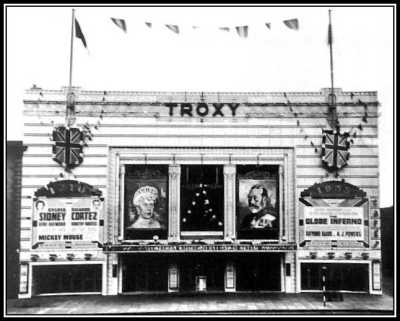 |
|
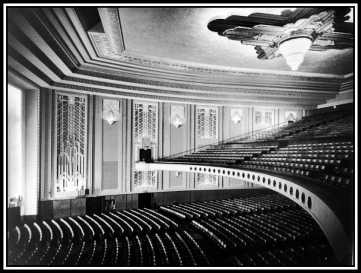 |
| The Troxy
Stepney |
I
would like to thank Mr.
Kevin Wheelen and Mr.
Brian Hall for providing
the photographs used
here. I am truly grateful
to them for their time
and effort.
Reflection
from Peter Thurgood
Regarding
the Standard Cinema
in Goldsmith Row: When
the cinema re-opened, I
was a teenager and had
recently moved around the
corner to Whiston Road. I
remember my mates and I
getting very excited, as
the American western
star, Forest Tucker was
personally going to open
it. I didn't get to see
him, but I did boast to a
few girls, saying that I
had.
AN APPEAL TO HELP SAVE THE OLD KENNINGHALL CINEMA
ON LOWER CLAPTON ROAD, HACKNEY
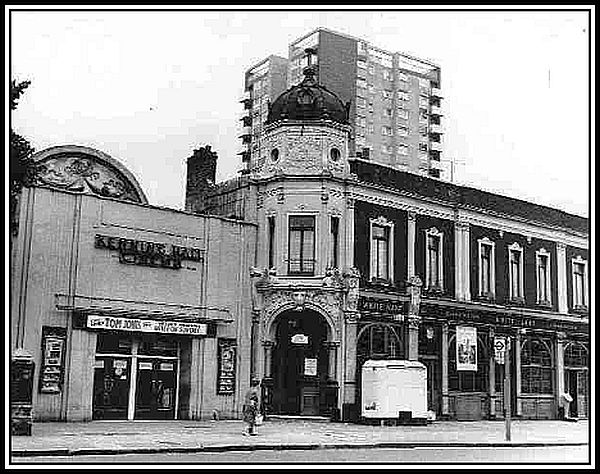
The Kenninghall Cinema in the 1960s
The photograph has been obtained from the Hackney Archives Department
Letter from:
The Secretary
Friends of Clapton Cinematograph Theatre
Dear Charles (and Visitors to this website):
I would be grateful if you would feature the following message on your wonderful website (Eastend Memories at http://eastend-memories.org). I am secretary of the Friends of Clapton Cinematograph Theatre and we are running a project to record the memories of anyone who used to go to the old Kenninghall Cinema on Lower Clapton Road, Hackney (a photograph of the cinema in the 1960s is shown above this letter). When it was built in 1910, it was known as the Clapton Cinematograph Theatre and it still retains its historic character, including the old cinema auditorium, gilded decorative barrel-vaulted ceiling and original proscenium arch. Information on the history of the building can be obtained from the following website: http://www.saveourcinema.org
Sadly it is now under threat from a planning application submitted to Hackney Council by its new owners, and an on-line petition has already collected over 700 signatures from local people and cinema historians, such as Dr Nicholas Hiley of Kent University, who says of the building "Such survivals from the earliest days of cinema are rare and should be preserved as an important part of British social history".
We are seeking to preserve not only the historic fabric of the building but also personal memories from residents and former residents of Clapton. So if you, a relative or friend used to go to children's matinees, cuddle up to your girlfriend or boyfriend in the back row or even sneak into a film through the fire exit, do get in touch with Julia Lafferty at info@saveourcinema.org.
With best wishes
Julia Lafferty
Secretary
Friends of Clapton Cinematograph Theatre
|